Create and Protect a ĎHoleí at the
Start
by David Dellenbaugh
When the starting signal goes off, every boat should have a nice hole to leeward. This allows you to accelerate off the line, sail your boat fast in the conditions and avoid getting pinched off or slowing in bad air.
 |
| The reliable port-tack approach No matter where on the line youíre planning to start or what type of boat youíre sailing, a port-tack approach usually works pretty well. This method allows you to see all the starboard tackers as they start to set up on the line, and you can pick a good place for tacking into the starboard line-up. There are typically two places where you might tack: 1) Above or below another boat; or 2) Between two boats. Here are some comments about each. |
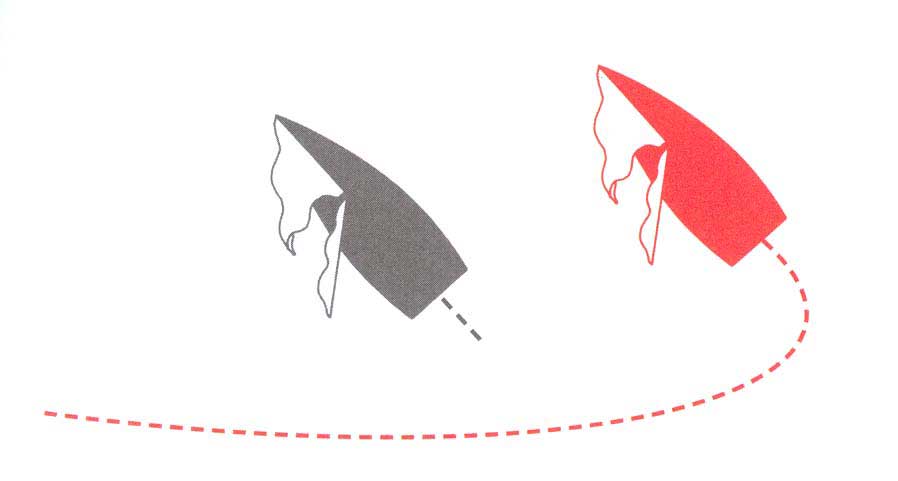 |
| Setting up near one boat This may sound backwards, but I usually set up on the windward side of a boat thatís already luffing near the line. I know that I will almost always end up with a boat to leeward of me at the start, so by tacking into this position I maintain some control over which boat is to leeward of me and how big a gap is between us. Of course, I look for a slow boat here and create a gap that is only as big as I can realistically defend. |
In order to start with a good space to leeward, your main tactical goal
during the last few minutes before the start should be to carve out and then
guard a hole on the line. This is not so easy to do, especially at a crowded
start. It requires good boathandling skills, rules knowledge and a number of
different tactical moves depending on the wind strength, waves and the type
of boat youíre racing.
In a dinghy, for example, you may need to sit in one place on the line for
the last two minutes. Heavy boats are always moving, they set up farther
away from the line and require a timed approach.
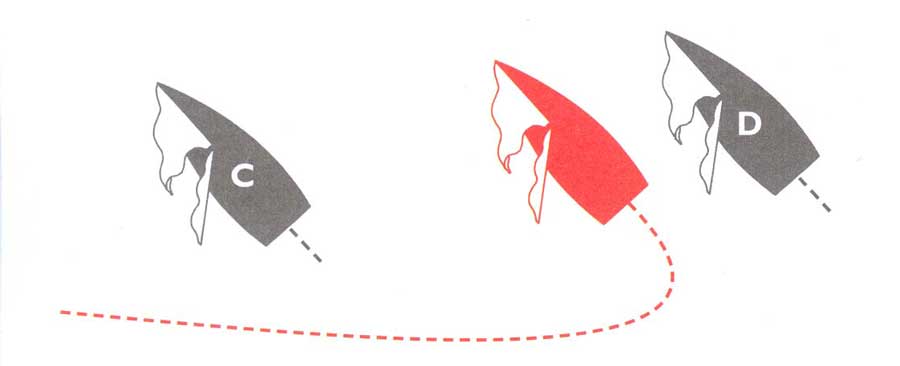 |
| Setting up between two boats When you are making a port-tack approach and the line is starting to get crowded, look for two luffing starboard tackers with a decent hole between them. In this situation, tack so you end up on the windward (right) side of the hole, just to leeward of the boat there (D). This gives you the largest possible hole to leeward (between you and C) with good control over the windward boat, D. |
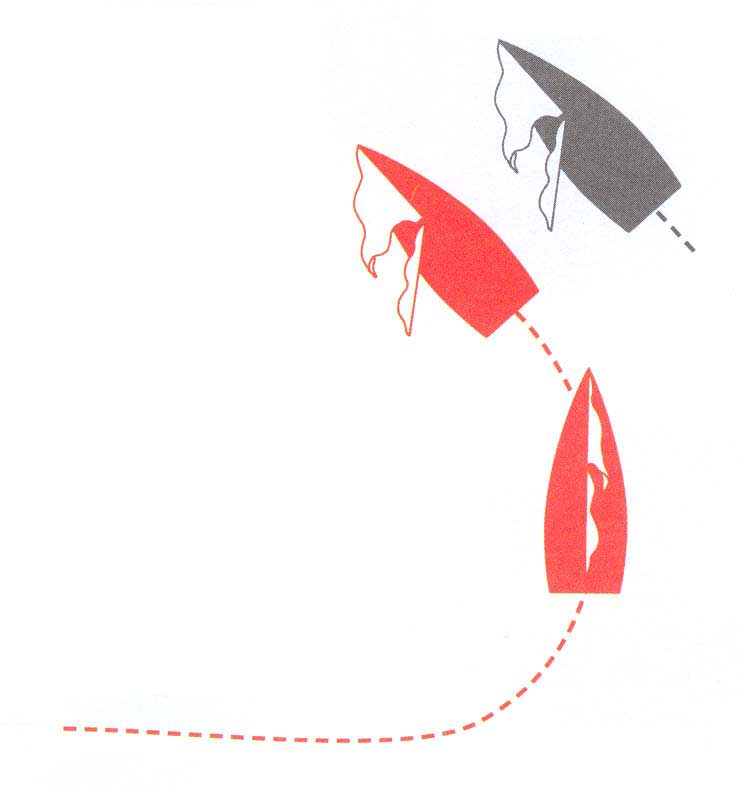 |
Tacking underneath another boat When you tack underneath a starboard tacker on the starting line, you usually want to end up quite close to leeward of them. This prevents them from bearing off behind you and allows you to control them by luffing. Itís not always easy to get close under the other boat, especially if they bear off at you to ďclose the door.Ē To prevent this, make your initial approach as if you are going to keep sailing past them on port tack. When you are almost astern of them and they have let down their guard, make a quick tack so you end up to leeward of them. If the other boat does bear off at you, begin your tack early so you donít foul them. As soon as you begin to tack, the other boat usually heads back up to close-hauled. Instead of making a normal tack, hold your boat head to wind so you glide up right underneath them and burn off your speed. |
ē Reserve your spot early. Itís usually better to set up a little too early
than too late, especially with dinghies and in lighter air. If you wait too
long on a crowded line, the front row will fill up and you may never have a
chance to create any space for yourself.
ē Shift right in your hole. Always keep working to the right in your hole,
toward the boat on your windward side. This gives you more control over that
boat and increases your space to leeward.
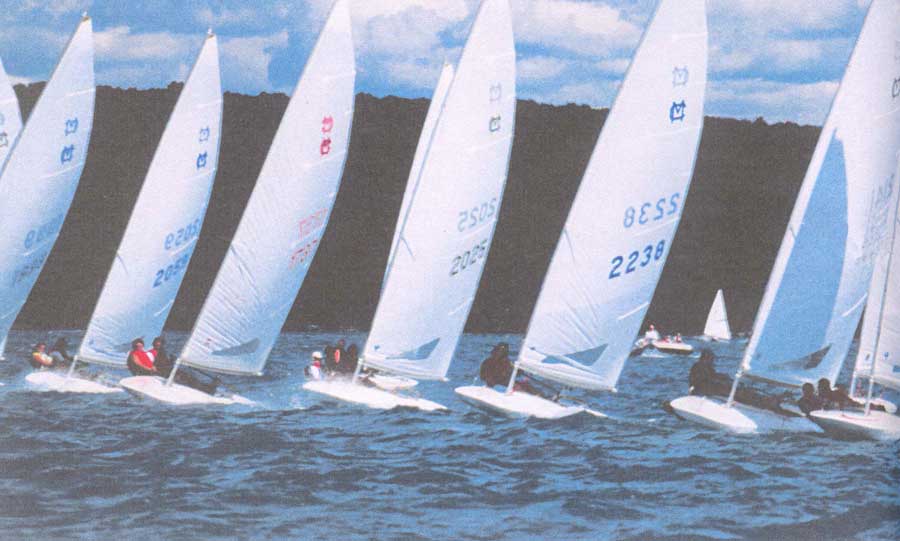 |
| Photo by JH Peterson |
ē Donít allow other boats to sail into your hole. Post a ďDo not enterĒ sign
around your space by aggressively defending it using the tactical moves
described at right.
ē Save your hole as long as you can. There are times when you must use up a
little of your hole to keep other boats out. But otherwise save it until the
start. If you trim too soon before the gun, for example, you will accelerate
too early and wind up just to windward of the boat on your leeward side.
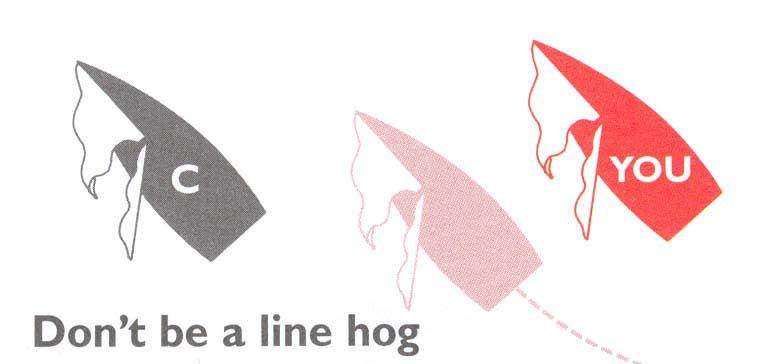 |
| 1. When you (A) are lined up for the start and youíre protecting a hole to leeward, beware of port tackers (B) coming from your leeward side. These latecomers are looking for a space where they can tack, and you definitely donít want them filling up the hole to leeward. Keep a good lookout and use the moves below to discourage them. |
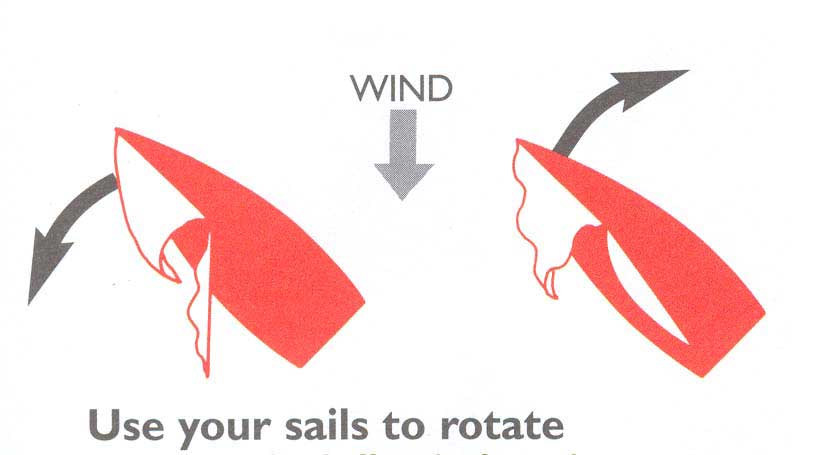 |
| When youíre luffing before the start, you often need to turn your boat sharply to defend your hole against other boats. Since you are going slowly and you donít want to move forward very far, you canít rely on your rudder for turning. Instead, you must use your sails to rotate. When you want to bear off, overtrim your jib and undertrim your main. When you need to head up, do the opposite. With this technique, you can almost spin your boat in place without moving forward. |
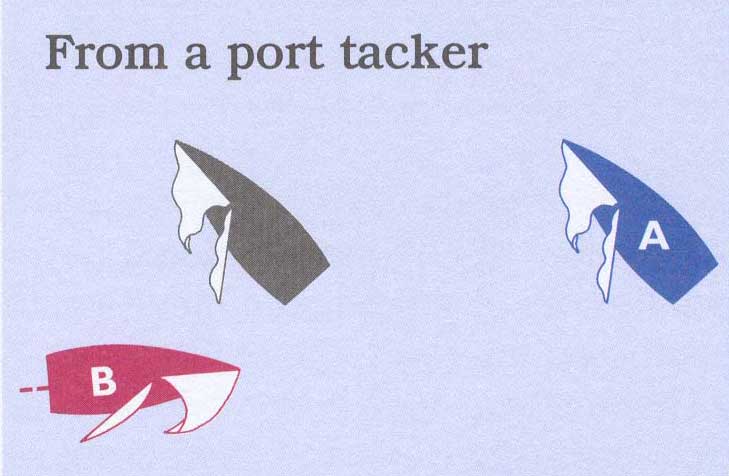 |
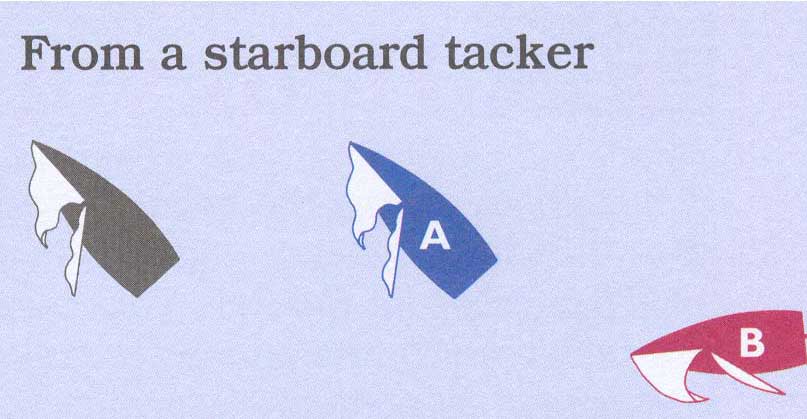 |
| 1. When you (A) are lined up for the start and youíre protecting a hole to leeward, beware of port tackers (B) coming from your leeward side. These latecomers are looking for a space where they can tack, and you definitely donít want them filling up the hole to leeward. Keep a good lookout and use the moves below to discourage them. | 1. Another threat to your leeward hole are starboard tackers (B) who canít find a spot on the line and start reaching along behind the front-row lineup, looking for a hole. Itís harder to see these boats coming, so keep an eye over your shoulder. Use the moves below to guard your space and avoid getting luffed head to wind. |
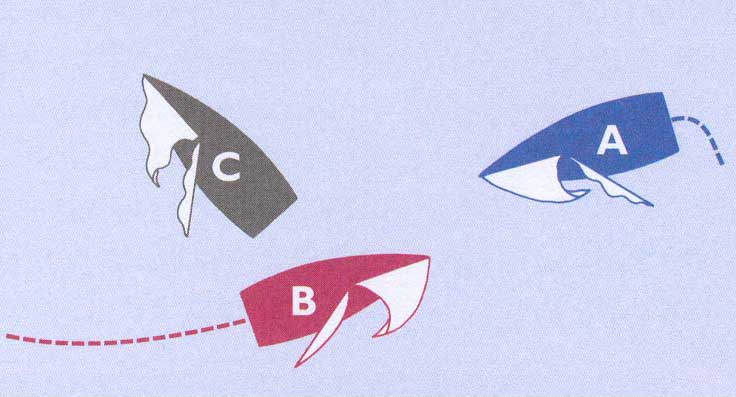 |
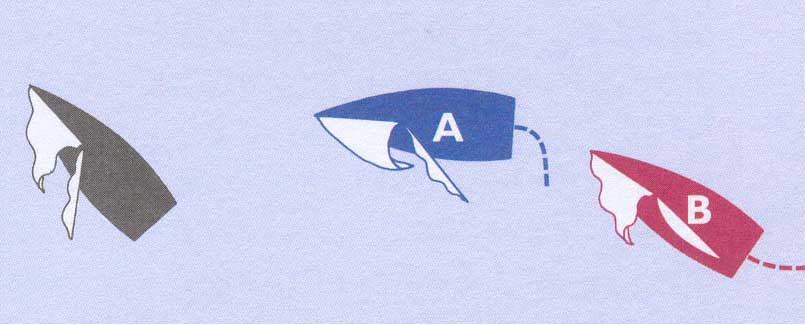 |
| 2. When you see a port tacker eyeing your hole, rotate your boat so you are aimed right at them. This will make it much harder for the port boat to tack into the hole on your leeward side. Try to rotate your boat without moving forward. If you go forward too much you will use up the hole youíve been protecting and end up just to windward of the leeward boat (C). Since youíre probably not moving through the water very fast, you canít turn with the rudder or by moving your weight. Instead, rotate by over-trimming your jib (or genoa) and letting your main out. | 2. When a starboard tacker comes from behind and threatens to sail into hour hole (and probably luff you in the process), discourage this by turning your boat to a reaching course, as if you are going to sail into your hole. Turn your boat with your sails and try not to move forward any farther than necessary (so you donít use up your hole). Push your boom out to take up more of your space. Try to make the other boat think there will be a better hole to windward of you than to leeward. |
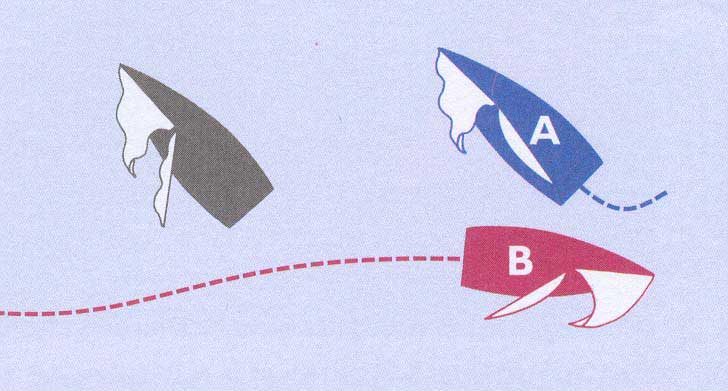 |
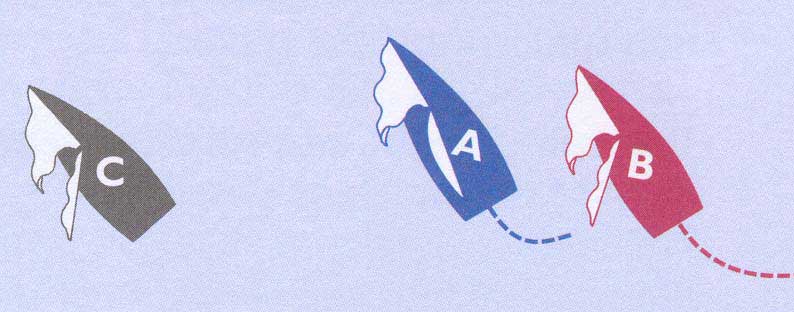 |
| 3. Your goal is to discourage the other boat from tacking into your hole and encourage them to keep sailing past your stern in search of a better space. As soon as the port tacker commits to passing astern of you, use your sails (trim main, ease jib) to rotate your boat back up to a closehauled course (or above) so you maintain as much of your hole as possible. | 3. As soon as the starboard tacker turns and commits to
going on your windward side, rotate quickly (using your sails) and luff
them toward the wind. This accomplishes two things: 1) It gives you control over the windward boat, which will be helpful when you come off the line; and 2) It moves you as far as possible from the boat on your leeward side (C). Instead of turning up to windward of you, itís possible the starboard tacker may continue past on your leeward side. As soon as she commits to going behind the boat to leeward of you (C), head up and maintain your hole. |
Dave publishes the newsletter Speed & Smarts. For a subscription call:
800-356-2200 or go to:
www.speedandsmarts.com
All contents are copyright (c) 2007 by
Northern Breezes, Inc. All information contained within is deemed reliable
but carries no guarantees. Reproduction of any part or whole of this
publication in any form by mechanical or electronic means, including
information retrieval is prohibited except by consent of the publisher.